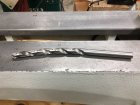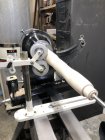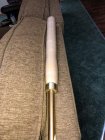I was making my first handle for a gouge I bought and was having trouble drilling a straight hole for the gouge to be glued into the handle. Do I need some kind of special jaws? It seems to wobble all over trying to use my 50mm nova jaws. I can drill a pretty straight hole with a hand held drill; maybe that's a better solution as I have three or four I'd like to turn.
-
May 2025 Turning Challenge: Long Neck Hollowform! (click here for details) -
Congratulations to Phil Hamel winner of the April 2025 Turning Challenge (click here for details) -
Congratulations to Paul Hedman and Donna Banfield for "Fire and Ice" being selected as Turning of the Week for 5 May, 2025 (click here for details) -
Welcome new registering member. Your username must be your real First and Last name (for example: John Doe). "Screen names" and "handles" are not allowed and your registration will be deleted if you don't use your real name. Also, do not use all caps nor all lower case.
You are using an out of date browser. It may not display this or other websites correctly.
You should upgrade or use an alternative browser.
You should upgrade or use an alternative browser.
Drilling a hole in a gouge handle
- Thread starter John Hicks
- Start date
Pretty straight is quite a relative term. Are you drilling the hole on the lathe first and then turning the outside? Start out with a center drill, then a jobber length bit, instead of doing a long twist drill. Forstner bits don't wander with the wood grain like a twist drill does, but requires a frequent pecking action to clear the chips.
- Joined
- Apr 27, 2004
- Messages
- 9,176
- Likes
- 5,795
- Location
- Lakeland, Florida
- Website
- www.hockenberywoodturning.com
Very slow speed. Any long spindle with a free end will tend to whip.
if possible drill the hole before turning. Clamp it in a vice drill with a hand held electric or battery powered.
What I often do is turn the handle with a spur drive on the handle end. Fit the Ferrell. And remove from the lathe.
Put a Jacobs chuck in the head stock with a brad point drill bit. Use a draw bar if you have one. Put masking tape on the bit to mark the depth.
Put the spur drive in the tail stock. Put the handle in the spur drive so it won’t turn. Turn the hand wheel until the brad point is in the hole from the tailstock pin. Rest my forearm in the tool rest so I can hold the handle still while I turn on the lathe - low speed. Then advance the handwheel once the drill has cut a tiny bit push the handle toward the tailstock to keep the spur drive seated. every inch of drill depth back out to clear the shavings.
Drill to the tape. Then back off the bit and turn off the lathe. this drills a pretty straight hole.
if possible drill the hole before turning. Clamp it in a vice drill with a hand held electric or battery powered.
What I often do is turn the handle with a spur drive on the handle end. Fit the Ferrell. And remove from the lathe.
Put a Jacobs chuck in the head stock with a brad point drill bit. Use a draw bar if you have one. Put masking tape on the bit to mark the depth.
Put the spur drive in the tail stock. Put the handle in the spur drive so it won’t turn. Turn the hand wheel until the brad point is in the hole from the tailstock pin. Rest my forearm in the tool rest so I can hold the handle still while I turn on the lathe - low speed. Then advance the handwheel once the drill has cut a tiny bit push the handle toward the tailstock to keep the spur drive seated. every inch of drill depth back out to clear the shavings.
Drill to the tape. Then back off the bit and turn off the lathe. this drills a pretty straight hole.
I have had a hard time getting twist or forstner bit to center where I want them to. Even if I use a center punch it always seems to deflect one way or another off the grain.
One thing I do that helps is to get a hole started where I want is to chuck up the work piece and use a gouge to make a divot in the center. If using a forstner but I will make the end of the piece concave a tad wide than the diameter of the bit. This helps a lot in my admittedly limited experience.
One thing I do that helps is to get a hole started where I want is to chuck up the work piece and use a gouge to make a divot in the center. If using a forstner but I will make the end of the piece concave a tad wide than the diameter of the bit. This helps a lot in my admittedly limited experience.
Cindy Drozda has a video on 'Making a removable wood handle using the removable aluminum adaptter' She shows a way using the tool rest and also mentions a second way using a chuck.
This is the link
View: https://www.youtube.com/watch?v=g-SN0llu0Cw
This is the link
Drilling the hole for the tool shank needs to be completed prior to contouring the shape of the handle. If you turn the blank round so it can be held securely in the chuck jaws you should have no problem drilling a straight hole. Slower speeds help while drilling holes in wood, start with a small pilot hole and take your time to make sure it goes in straight, this will keep the larger drill bit centered while drilling the finish size bore hole for the tool shank. If you have a center point on both ends of the spindle blank, you can drill the shank hole and reverse mount the handle jamb chucking the bore hole onto a proper sized steel pin or wood dowel in the chuck and using the tailstock to center up on the butt of the handle and finish turning the contour of the handle. If you contour the handle prior to drilling the tool shank bore hole you will have a hard time holding the handle squarely in the chuck jaws. Having a tenon on both ends of the spindle blank with center holes will also make it easy to reverse mount and drill straight holes in a handle. I use that method when turning case formers for the Pyrotechnic guild.
I use my Oneway spindle steady rest to keep the tool handle running true while drilling
Once I have the handle almost turned, I chuck the butt end into a 4 jaw, bring up the tail stock, set the spindle steady, then back off the tail stock and set the spindle steady.
Then I set up to drill.
Once I have the handle almost turned, I chuck the butt end into a 4 jaw, bring up the tail stock, set the spindle steady, then back off the tail stock and set the spindle steady.
Then I set up to drill.
Roger Wiegand
Beta Tester
Good quality Forstner bits make a difference. The old set I bought many years ago has points that are no where near the center, some of them aren't round. Clearly problematic. I've recently found the Colt Maxi-cut bits and #2 MT socket, so you don't need a jacobs chuck. Makes a world of difference in being able to cut nice holes. Really wonky grain will still throw them off a little bit. I always drill my blanks first then use a cone on the tailstock to center them perfectly for the rest of the turning process.
Machinists use #2 MT twist drills a lot it seems, I've been able to pick up a nearly full set for a dollar or two each at the used tool shop.
Machinists use #2 MT twist drills a lot it seems, I've been able to pick up a nearly full set for a dollar or two each at the used tool shop.



